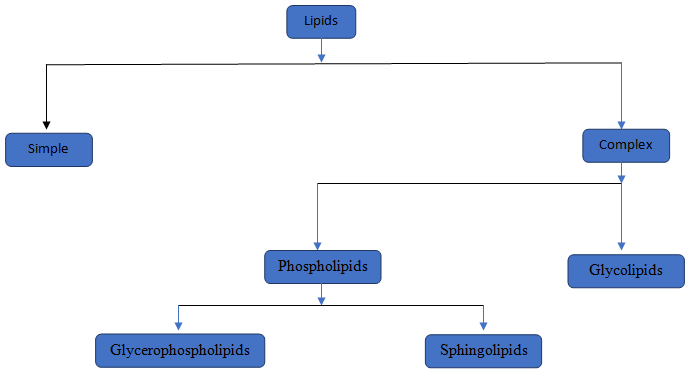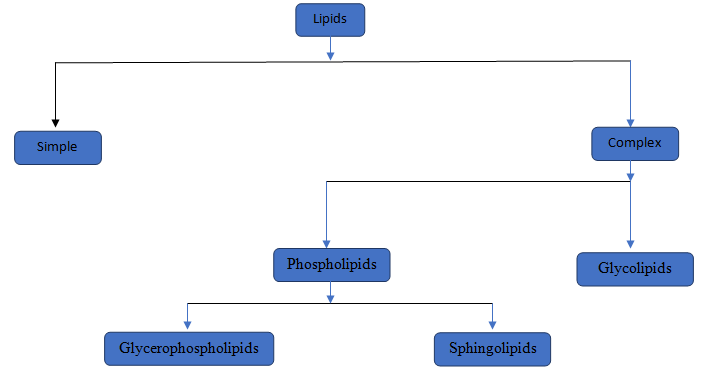
(a)
Interpretation:
The category to which the given lipid structure belongs should be identified.
Concept Introduction:
Lipids are a type of chemical substances which is not soluble in water but soluble in non-polar solvents. Lipids are of two type simple lipids and complex lipids. Simple lipids are those where Glycerol attached with fatty acid. In complex lipids there are two major lipids i, e, Phospholipids and Glycolipids.

(b)
Interpretation:
The components of the compound should be determined.
Concept Introduction:
Lipids are a type of chemical substances which is not soluble in water but soluble in non-polar solvents. Lipids are of two type simple lipids and complex lipids. Simple lipids are those where Glycerol attached with fatty acid. In complex lipids there are two major lipids i,e, Phospholipids and Glycolipids.

Trending nowThis is a popular solution!

Chapter 20 Solutions
Introduction To General, Organic, And Biochemistry
- 3.3 Consider the variation of molar Gibbs energy with pressure. 3.3.1 Write the mathematical expression for the slope of graph of molar Gibbs energy against 3.3.2 pressure at constant temperature. Draw in same diagram graphs showing variation with pressure of molar Gibbs energies of a substance in gaseous, liquid and solid forms at constant temperature. 3.3.3 Indicate in your graphs melting and boiling points. 3.3.4 Indicate for the respective phases the regions of relative stability.arrow_forwardIn 2-chloropropane, the signal for the H on the C next to Cl should be split into how many peaks?arrow_forward4.4 Consider as perfect gas 3.0 mol of argon gas to which 229 J of energy is supplied as heat at constant pressure and temperature increases by 2.55 K. Calculate 4.4.1 constant pressure molar heat capacity. 4.4.2 constant volume molar heat capacity.arrow_forward
- 3.2 32 Consider calibrating a calorimeter and measuring heat transferred. A sample of compound was burned in a calorimeter and a temperature change of 3.33°C recorded. When a 1.23 A current from a 12.0 V source was passed through a heater in the same calorimeter for 156 s, the temperature changed of 4.47°C was recorded. 3.2.1 Calculate the heat supplied by the heater. 3.2.2 Calculate the calorimeter constant. 3.2.3 Calculate the heat released by the combustion reaction.arrow_forward-.1 Consider the standard enthalpy of formation of gaseous water at 25°C as -241.82 kJ/mol and calculate the standard enthalpy of formation of gaseous water at 100°C.arrow_forward3.5 Complete the following sentences to make correct scientific meaning. 3.5.1 The entropy of a perfect gas. 3.5.2 when it expands isothermally. The change in entropy of a substance accompanying a change of state at its transition 3.5.3 temperature is calculated from its of transition. The increase in entropy when a substance is heated is calculated from itsarrow_forward
- 3.4 Consider the internal energy of a substance 3.4.1 Draw a graph showing the variation of internal energy with temperature at constant volume 3.4.2 Write the mathematical expression for the slope in your graph in 3.4.1arrow_forwardFor a system, the excited state decays to the ground state with a half-life of 15 ns, emitting radiation of 6000 Å. Determine the Einstein coefficients for stimulated absorption and spontaneous emission and the dipole moment of the transition. Data: epsilon 0 = 8.85419x10-12 C2m-1J-1arrow_forwardProblem a. The following compounds have the same molecular formula as benzene. How many monobrominated products could each form? 1. HC =CC=CCH2CH3 2. CH2=CHC = CCH=CH₂ b. How many dibrominated products could each of the preceding compounds form? (Do not include stereoisomers.)arrow_forward
 Introduction to General, Organic and BiochemistryChemistryISBN:9781285869759Author:Frederick A. Bettelheim, William H. Brown, Mary K. Campbell, Shawn O. Farrell, Omar TorresPublisher:Cengage Learning
Introduction to General, Organic and BiochemistryChemistryISBN:9781285869759Author:Frederick A. Bettelheim, William H. Brown, Mary K. Campbell, Shawn O. Farrell, Omar TorresPublisher:Cengage Learning Introductory Chemistry: An Active Learning Approa...ChemistryISBN:9781305079250Author:Mark S. Cracolice, Ed PetersPublisher:Cengage Learning
Introductory Chemistry: An Active Learning Approa...ChemistryISBN:9781305079250Author:Mark S. Cracolice, Ed PetersPublisher:Cengage Learning World of ChemistryChemistryISBN:9780618562763Author:Steven S. ZumdahlPublisher:Houghton Mifflin College Div
World of ChemistryChemistryISBN:9780618562763Author:Steven S. ZumdahlPublisher:Houghton Mifflin College Div Chemistry: Principles and PracticeChemistryISBN:9780534420123Author:Daniel L. Reger, Scott R. Goode, David W. Ball, Edward MercerPublisher:Cengage Learning
Chemistry: Principles and PracticeChemistryISBN:9780534420123Author:Daniel L. Reger, Scott R. Goode, David W. Ball, Edward MercerPublisher:Cengage Learning Chemistry for Today: General, Organic, and Bioche...ChemistryISBN:9781305960060Author:Spencer L. Seager, Michael R. Slabaugh, Maren S. HansenPublisher:Cengage Learning
Chemistry for Today: General, Organic, and Bioche...ChemistryISBN:9781305960060Author:Spencer L. Seager, Michael R. Slabaugh, Maren S. HansenPublisher:Cengage Learning





